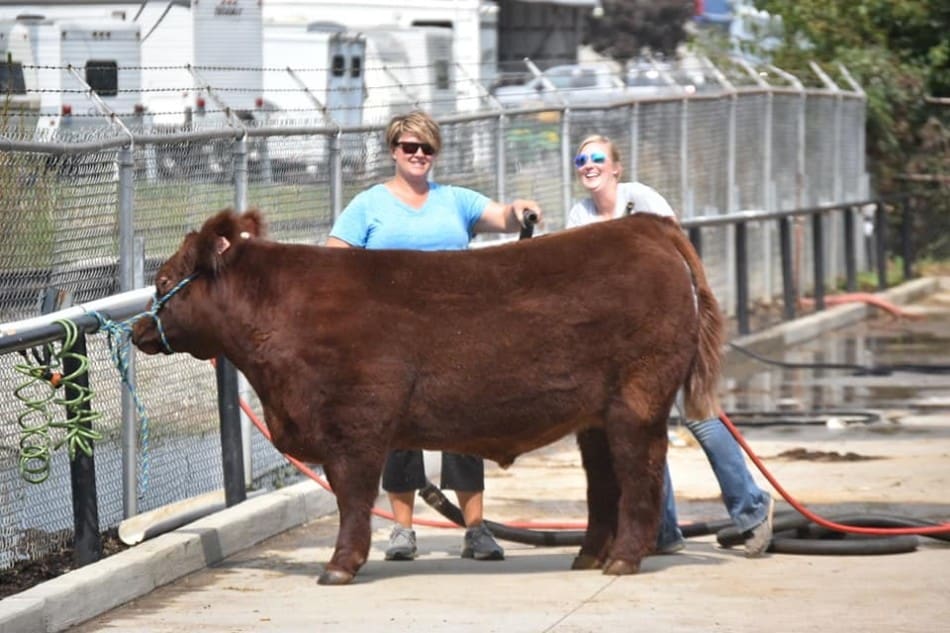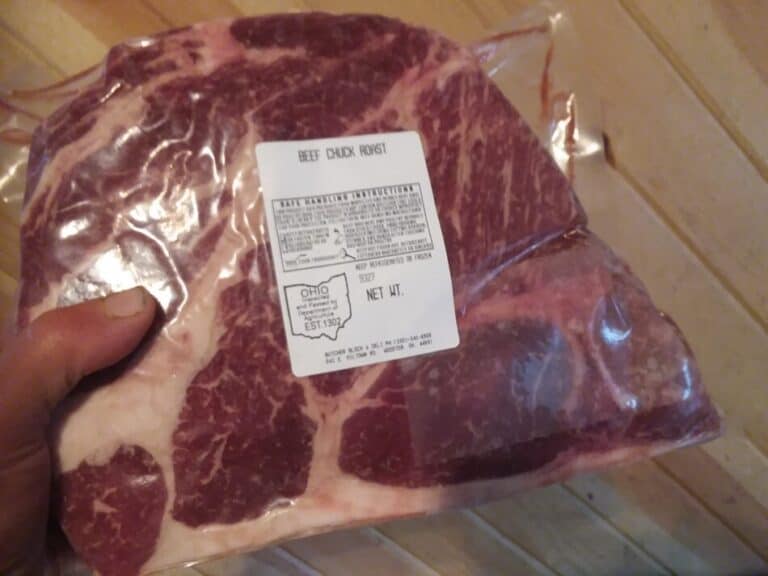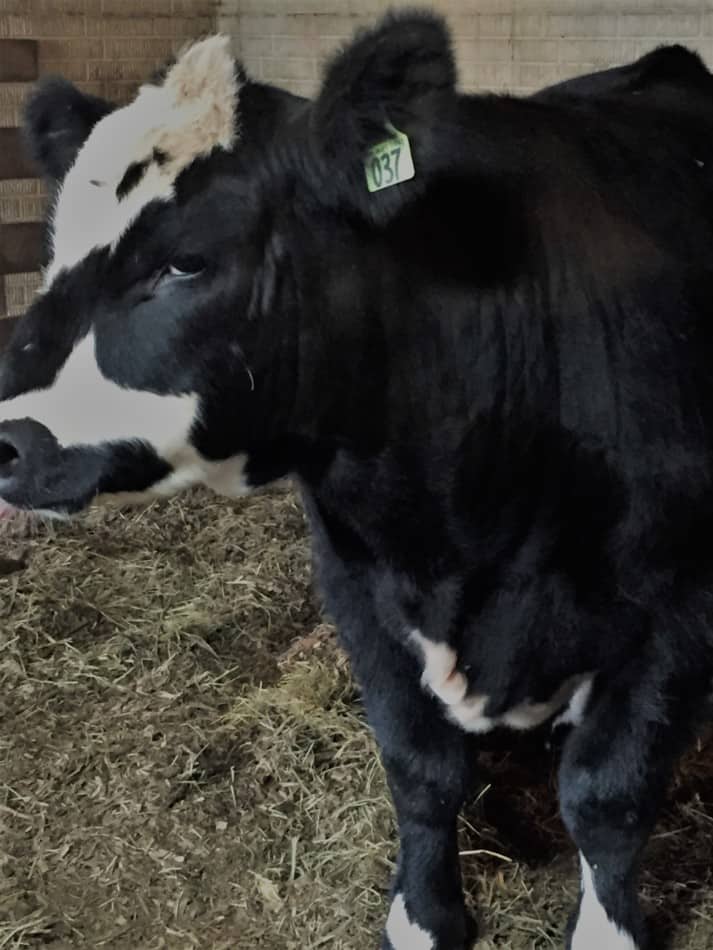Buying Beef Cattle: Starter Herd Cost

Getting your first few cattle is an exciting time! Now you can start putting together a plan, starting with price.
What are your options to get started raising cattle and how much should you plan on spending?
Generally speaking, bred cows and bred heifers cost $1,200 each and the bull $2,000. Cost varies with region, time of year and genetics of the cattle.
Raising cattle successfully depends greatly upon what animals you start with and price is a big determiner of what cattle you are likely to start with.
We’ll be looking into the costs and considerations of starting a small commercial beef herd.
These three subjects covered in previous articles, so I won’t be boring you by repeating them here:
Cost of feeding your new herd is covered in my article Beef Cattle: Beginner’s Guide To Feed Costs.
If you are interested in where to buy your cattle read my article Getting Started With Beef Cattle: Buying Your Starter Herd.
What will it take to care for your new cattle? Read my article Beginning With Beef Cattle: How To Care For Your New Herd
Determine the cost per cow
Sometimes determining the price of cattle is easy, it’s listed right in the sale or auction report.
Price per head/each is how breeding stock cattle sell in my area, no math required!
Figure cow prices from selling price
To get the price in your area, you might need to dig into the numbers a bit or just do some math to get an idea of price per head.
If you need to calculate the price per pound, the math is simple.
Price per pound x weight of cow = price of cow
For example: if the price listed is $1.72 per pound, you take $1.72 and multiply by her weight. If she weighs 1,000 pounds, she cost $1,720.
If the price is listed in cwt that means price per one hundred pounds, called hundredweight. If the same cow price listed above was done as a hundredweight price, the sale report would list $172, which is $172/cwt.
The math looks like this:
1,000 pound cow divided by 100 pounds = 10 cwt
10 cwt x $172 = $1,720 each for the cow
The only difference here is how the selling price is handled in the sales ring. The final results are the same price for the cow no matter which method is used to figure it up.
In my area, breeding stock is sold by the head
As I mentioned above, in my area breeding stock is sold by the head. You’ll need to figure out which is the common method for your area.
Any sale that is specifically breeding stock only, usually breed sponsored sales or show prospects, will be sold by the head.
From the prices I’m seeing around here, I would expect to pay $1,200 each for a commercial cow.
By commercial cow, I am referring to an average performing, nice looking cow that will produce a good calf every year.
Update: right now (late summer 2023) cattle prices are much higher than this, closer to $2,000 each, feeder steers are up significantly, as well.
If you are looking for something special, like specific genetics, an unusual breed, show stock or a breed or cross breed in high demand then you should expect to pay more.
Profitable Cattle Marketing for the Cow Calf Producer is a University of Georgia Extension article that goes into quite a bit of detail with yearly expenses for brood cows and calves.

High quality cows will cost more
High quality cows will cost more and be worth more!
Not in just resale value but in everyday little costs that aren’t going to be getting tacked on every time you turn around, like will happen if you cheap out.
Quality pays, this can not be overstated.
It seems counter-intuitive, but paying more for a great cow to start with will actually save you money through out the coming years.
Especially when compared to buying a “deal” that turns into a money pit.
Rock bottom cow prices are for poor quality cattle
A few weeks ago we went down and watched part of the weekly auction, it was in the evening, so they were onto cattle for beef.
The nice looking beef breed cows were bringing $0.70 per pound. At around 1,000 pounds that’s $700 each.
I’m sure you’re thinking “what does slaughter price (the $0.70/pound) have to do with brood cow price?” A great deal, actually.
When a nice looking beefy cull cow is selling for $700, the high quality, make you money cow that is due to calve in the spring is going to cost you more.
Look through the recent auction reports for your area and be familiar with the cull price.
Cull price is rock bottom, junky used car that will hopefully get you to work and back type price.
If you are okay with a poor quality cow, then you can expect to pay $500-700 for her.
If you are looking for a nice cow that will produce for you, you need to set your sights higher.
Variables will affect cost of cow
The most common variable affecting brood cow price is seasonality.
If the herd is going into calving season and you want to buy your starter herd right before the calves are born, expect to pay more.
These cattle are just shy of having the most expenses in them for the year and not returning any money to the owner yet.
He would have put in all the time and the hay cost of overwintering these cattle. Now they are at the best time of the year to get them from a buyers point of view.
However, they are also at just reaching the point where the owner can be confident those gals will make him money this grazing season.
Now that all the winter work is nearly over, you’ll need to pay for the work the owner did over the off season to get the cows ready for you.
Occasionally you will be able to find a seller who needs to reduce the herd size a bit or has decided to go a different direction with his herd genetics, so he’s got a few extras on hand.
If you like the cattle he has for sale, here’s a great opportunity for you both.
Start with cows, not heifers
It is likely to be less expensive to start with yearling heifers and get them bred at 15 months of age, then calve them out as your first beef cattle.
Since you are inexperienced, don’t do it.
Heifers are generally more nervous than a cow, all this having a baby stuff is new.
Also, carefully go over your expenses, you may be surprised at what you will need to put into those heifers to get them up to calving.
Not to mention, not all heifers will breed. Sad but true.
Since you are new, you are more likely to keep an open (unbred) heifer around than someone with more experience.
Heifers that do not calve as planned are costing you money, since they eat but don’t produce. The experienced cattleman would see the problem, you may not.
Since you haven’t spent time with cattle, you might not see this one coming-open heifers are feisty! Open means not bred.
I’m not sure if it’s the cattle equivalent of teenage hormones or what, but prepare yourself. Once she gets to be a year or so old up to when she’s bred and settled (pregnant) she’ll be a handful.
The other consideration with heifers is the bull. Ready or not, here he has to come if you need those heifers bred!
When you are new to cattle, dealing with a bull is another skill that you have not developed yet. If you decide to get a bull instead of going with A.I. that’s another skill you’ll need to work on developing.
For now, focus on learning the girls, then take on another project.

Start with older cows in good shape
This is a great idea and the option I would go with if I were looking to get into beef cattle yet spend a bit less money, while still getting decent genetics.
Once a cow gets to 6 or 7 years old, she’s not looked at as being young any more. If she is a high quality animal she’ll easily have a productive years as a brood cow ahead of her.
“If she’s so great, why would that guy be selling her?” Good question, here’s why: he has had her for 4 or 5 calvings so far.
Meaning she is the mom of 2-3 replacement heifers that, if he’s doing a good job with selection, should be better suited to his farm and management than an older cow.
“That guy” is keeping the 2-3 replacement heifers and giving you the opportunity to buy a great older cow. Take the opportunity!
Cows can easily be productive past 10 years of age, especially in a small farm setting. If you come across great older cows, as long as they are bred and extras (not culls), go for it.
Please reread that last sentence and note bred and extras. These two words are the key differences between success and failure.
If she is bred and in good condition, she’s a potential keeper. If she’s open (not bred), in poor condition, poor health, or has physical problems like bad udder, she is a cull!
A final caution: I do not like dealing with fruit loop attitudes. A beautiful cow with a bad attitude is not something I want around.
Ask why are these girls for sale? You are looking for the reasons other than age: attitude, didn’t raise a calf, refuses to stay in the fence, etc.
If her only “crime” is being older, she’d be just the gal I’m looking for.
If the reason for selling her is anything else, do yourself a favor and pass. Buy cows that you will enjoy raising.
Get all of the cattle from one farm
Your cows will be easier for you to manage if they all come from one place.
They will be used to the same management and most likely be closer genetically, meaning they will be similar for you to take care of.
Getting a few cattle here and a few cattle there will give you a mix of management needs for the group and increases the chance of bringing in problems, like diseases.
If you choose to get a variety pack of brood cows, you can manage them all the same and cull out the non performers.
It will take time (years) and can be a costly way to start. You’ll be better off getting all of your cattle from the same farm.
Purebred or crossbred herd is your choice
Raising purebred or crossbred cattle is completely up to you.
By far the most popular cattle in the U.S. today are Angus and Angus cross.
Angus cattle have a great reputation as being a super beef producer and the marketers behind the breed have done a wonderful job promoting their own beef.
If you are looking for the best breed for your farm, consider looking a bit deeper into your options.
There are many breeds of cattle available in the U.S. that will do a great job for you on your farm.
If you are wanting the popular choice, right now it’s Angus and Angus cross cattle. Just because Angus are popular, does not mean they are perfect! Find a breed or cross that works for you and your area!
Plenty of other breeds, like Hereford, Shorthorn, Simmental and Charolais (just to name a few) are great cattle that will perform for you and be wonderful choices, as well.
I have an article 14 Docile Breeds of Cattle, focusing on cattle great for beginners that you can check out and be sure to look into Pharo Cattle Company. They have great genetics and the site is full of useable information.
Registering your cattle is not necessarily profitable
A note on purebred or registered cattle: if having purebred or registered cattle means a lot to you, then make it happen.
If you are hoping that by having registered or purebred stock you will get higher prices at the weekly auction, think again.
High quality, great looking, beefy finished animals are bringing the best prices.
Note I did not list registered or purebred! Don’t get me wrong, I love purebred and registered stock.
My purpose here is to point out that it is an extra cost that may or may not be worth the extra money.
If you are planning on private sales, breed may be a big deal to your customers.
If you aren’t private selling, it probably is not the big deal that you are thinking it is.
Beef price is based on value
Price is not about breed alone, it’s about quality and value for the dollar that the meat buyers are spending.
Their customers, the slaughter houses, want carcasses that yield (have lots of retail cuts) and are high quality (marbled).
If your steers are providing a great value for the selling price then you will get some of the higher prices for the day. If not, you won’t.
Being a seller of the popular breed of cattle does not mean you will get great prices for anything you send through the ring.
Only the top of the line, well finished steers will get the high prices. It’s not color, breed or name, it’s value.
As a new producer, be sure you understand what you are getting into with your cattle. Where I’m going here is attitude.
Some breeds of cattle, Angus included here, can be more high strung than others.
As I’ve mentioned above, attitude is a big deal to me, if it is to you as well, consider a breed known for being calm and more easy to deal with.
So You Want To Raise Beef Cattle? is from Penn State Extension going over the basics of getting into cattle. Their thoughts are a bit different than mine, check them out if you want an additional perspective on getting into cattle.




